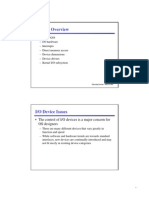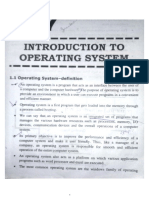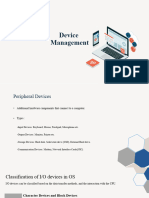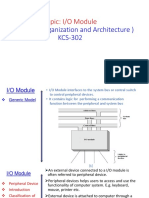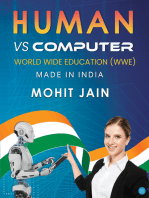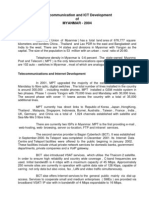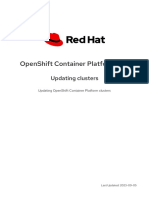0 ratings0% found this document useful (0 votes)
23 viewsInput Output Hardware
The document discusses how operating systems manage I/O devices through device drivers and controllers. It describes two categories of devices - block devices which communicate via entire data blocks and character devices which use single characters. Device controllers act as an interface between devices and their corresponding device drivers. The CPU communicates with I/O devices using memory-mapped I/O, special I/O instructions, or direct memory access which allows data transfer without CPU involvement. Interrupts provide more efficient I/O than polling by allowing devices to signal the CPU when needing attention.
Uploaded by
mmmoneyyyy2Copyright
© © All Rights Reserved
Available Formats
Download as DOCX, PDF, TXT or read online on Scribd
0 ratings0% found this document useful (0 votes)
23 viewsInput Output Hardware
The document discusses how operating systems manage I/O devices through device drivers and controllers. It describes two categories of devices - block devices which communicate via entire data blocks and character devices which use single characters. Device controllers act as an interface between devices and their corresponding device drivers. The CPU communicates with I/O devices using memory-mapped I/O, special I/O instructions, or direct memory access which allows data transfer without CPU involvement. Interrupts provide more efficient I/O than polling by allowing devices to signal the CPU when needing attention.
Uploaded by
mmmoneyyyy2Copyright
© © All Rights Reserved
Available Formats
Download as DOCX, PDF, TXT or read online on Scribd
You are on page 1/ 6
Operating System - I/O Hardware
One of the important jobs of an Operating System is to manage
various I/O devices including mouse, keyboards, touch pad, disk
drives, display adapters, USB devices, Bit-mapped screen, LED,
Analog-to-digital converter, On/off switch, network connections,
audio I/O, printers etc.
An I/O system is required to take an application I/O request and
send it to the physical device, then take whatever response
comes back from the device and send it to the application. I/O
devices can be divided into two categories −
Block devices − A block device is one with which the driver
communicates by sending entire blocks of data. For
example, Hard disks, USB cameras, Disk-On-Key etc.
Character devices − A character device is one with which the
driver communicates by sending and receiving single
characters (bytes, octets). For example, serial ports, parallel
ports, sounds cards etc
Device Controllers
Device drivers are software modules that can be plugged into an
OS to handle a particular device. Operating System takes help
from device drivers to handle all I/O devices.
The Device Controller works like an interface between a device
and a device driver. I/O units (Keyboard, mouse, printer, etc.)
typically consist of a mechanical component and an electronic
component where electronic component is called the device
controller.
There is always a device controller and a device driver for each
device to communicate with the Operating Systems. A device
controller may be able to handle multiple devices. As an interface
its main task is to convert serial bit stream to block of bytes,
perform error correction as necessary.
Any device connected to the computer is connected by a plug and
socket, and the socket is connected to a device controller.
Following is a model for connecting the CPU, memory, controllers,
and I/O devices where CPU and device controllers all use a
common bus for communication.
Synchronous vs asynchronous I/O
Synchronous I/O − In this scheme CPU execution waits while
I/O proceeds
Asynchronous I/O − I/O proceeds concurrently with CPU
execution
Communication to I/O Devices
The CPU must have a way to pass information to and from an I/O
device. There are three approaches available to communicate
with the CPU and Device.
Special Instruction I/O
Memory-mapped I/O
Direct memory access (DMA)
Special Instruction I/O
This uses CPU instructions that are specifically made for
controlling I/O devices. These instructions typically allow data to
be sent to an I/O device or read from an I/O device.
Memory-mapped I/O
When using memory-mapped I/O, the same address space is
shared by memory and I/O devices. The device is connected
directly to certain main memory locations so that I/O device can
transfer block of data to/from memory without going through
CPU.
While using memory mapped IO, OS allocates buffer in memory
and informs I/O device to use that buffer to send data to the
CPU. I/O device operates asynchronously with CPU, interrupts
CPU when finished.
The advantage to this method is that every instruction which can
access memory can be used to manipulate an I/O device. Memory
mapped IO is used for most high-speed I/O devices like disks,
communication interfaces.
Direct Memory Access (DMA)
Slow devices like keyboards will generate an interrupt to the main
CPU after each byte is transferred. If a fast device such as a disk
generated an interrupt for each byte, the operating system would
spend most of its time handling these interrupts. So a typical
computer uses direct memory access (DMA) hardware to reduce
this overhead.
Direct Memory Access (DMA) means CPU grants I/O module
authority to read from or write to memory without involvement.
DMA module itself controls exchange of data between main
memory and the I/O device. CPU is only involved at the beginning
and end of the transfer and interrupted only after entire block has
been transferred.
Direct Memory Access needs a special hardware called DMA
controller (DMAC) that manages the data transfers and arbitrates
access to the system bus. The controllers are programmed with
source and destination pointers (where to read/write the data),
counters to track the number of transferred bytes, and settings,
which includes I/O and memory types, interrupts and states for
the CPU cycles.
The operating system uses the DMA hardware as follows −
Step Description
1 Device driver is instructed to transfer disk data to a buffer address X.
2 Device driver then instruct disk controller to transfer data to buffer.
3 Disk controller starts DMA transfer.
4 Disk controller sends each byte to DMA controller.
DMA controller transfers bytes to buffer, increases the memory
5
address, decreases the counter C until C becomes zero.
When C becomes zero, DMA interrupts CPU to signal transfer
6
completion.
AD
Polling vs Interrupts I/O
A computer must have a way of detecting the arrival of any type
of input. There are two ways that this can happen, known
as polling and interrupts. Both of these techniques allow the
processor to deal with events that can happen at any time and
that are not related to the process it is currently running.
Polling I/O
Polling is the simplest way for an I/O device to communicate with
the processor. The process of periodically checking status of the
device to see if it is time for the next I/O operation, is called
polling. The I/O device simply puts the information in a Status
register, and the processor must come and get the information.
Most of the time, devices will not require attention and when one
does it will have to wait until it is next interrogated by the polling
program. This is an inefficient method and much of the
processors time is wasted on unnecessary polls.
Compare this method to a teacher continually asking every
student in a class, one after another, if they need help. Obviously
the more efficient method would be for a student to inform the
teacher whenever they require assistance.
Interrupts I/O
An alternative scheme for dealing with I/O is the interrupt-driven
method. An interrupt is a signal to the microprocessor from a
device that requires attention.
A device controller puts an interrupt signal on the bus when it
needs CPU’s attention when CPU receives an interrupt, It saves
its current state and invokes the appropriate interrupt handler
using the interrupt vector (addresses of OS routines to handle
various events). When the interrupting device has been dealt
with, the CPU continues with its original task as if it had never
been interrupted.
You might also like
- Huawei BBU 3900-5900 Configuration File (XML) Download From FTP Server.86% (7)Huawei BBU 3900-5900 Configuration File (XML) Download From FTP Server.4 pages
- UNIT IV - IO Management - Disk SchedulingNo ratings yetUNIT IV - IO Management - Disk Scheduling11 pages
- Computer Organization & Architecture Lecture #19 Input/OutputNo ratings yetComputer Organization & Architecture Lecture #19 Input/Output18 pages
- Unit-7 I_o Management and Scheduling (1)No ratings yetUnit-7 I_o Management and Scheduling (1)47 pages
- Input/Output: The Computer's Response Time Is No Match For OursNo ratings yetInput/Output: The Computer's Response Time Is No Match For Ours108 pages
- OS - Chapter - 6 - Input Output ManagementNo ratings yetOS - Chapter - 6 - Input Output Management21 pages
- Lecture-07, Adv. Computer Architecture, CS-522No ratings yetLecture-07, Adv. Computer Architecture, CS-52249 pages
- Unit-7 I_o Management and Scheduling (1)No ratings yetUnit-7 I_o Management and Scheduling (1)47 pages
- Basic I/O System Design: Department of Computer Science & Engineering BRAC UniversityNo ratings yetBasic I/O System Design: Department of Computer Science & Engineering BRAC University30 pages
- Define the term _I_O organization_ in the context...No ratings yetDefine the term _I_O organization_ in the context...2 pages
- Operating System 2nd Edition - Topik 11No ratings yetOperating System 2nd Edition - Topik 1157 pages
- Lec 7 I-o Modules-computer ArchitectureNo ratings yetLec 7 I-o Modules-computer Architecture32 pages
- William Stallings Computer Organization and Architecture 9 EditionNo ratings yetWilliam Stallings Computer Organization and Architecture 9 Edition36 pages
- Computer and Operating System StructureNo ratings yetComputer and Operating System Structure18 pages
- Name: S.Sai Ritheesh Reg No: 19BEC0847 Course Code: Ece3004 Faculty Name: Pradheep T Lab Slot: F1+TF1 DA: 1No ratings yetName: S.Sai Ritheesh Reg No: 19BEC0847 Course Code: Ece3004 Faculty Name: Pradheep T Lab Slot: F1+TF1 DA: 19 pages
- Input/Output: Booc, Jecren G. Damayo, John Reil A. Ilaga, Judilo A Notarte, Mark Neil PNo ratings yetInput/Output: Booc, Jecren G. Damayo, John Reil A. Ilaga, Judilo A Notarte, Mark Neil P55 pages
- Computer System Structure and ComponentsNo ratings yetComputer System Structure and Components5 pages
- LAB # 04 Data Retrieval Operations Using Join OperationsNo ratings yetLAB # 04 Data Retrieval Operations Using Join Operations6 pages
- Cambridge International General Certificate of Secondary EducationNo ratings yetCambridge International General Certificate of Secondary Education12 pages
- Telecommunication and ICT Development of Myanmar 2004No ratings yetTelecommunication and ICT Development of Myanmar 20043 pages
- Bugcrowd Vulnerability Rating Taxonomy 1No ratings yetBugcrowd Vulnerability Rating Taxonomy 114 pages
- Exchange Brick-Level Backup and Restore: WhitepaperNo ratings yetExchange Brick-Level Backup and Restore: Whitepaper18 pages
- Defending against the rising tide - Navigating the complex cyber threat landscapeNo ratings yetDefending against the rising tide - Navigating the complex cyber threat landscape6 pages
- EMPLOYEE DATA ANALYSIS SYSTEM (IP CLASS XII)No ratings yetEMPLOYEE DATA ANALYSIS SYSTEM (IP CLASS XII)26 pages
- Openshift Container Platform 4.13 Updating Clusters en Us CLNo ratings yetOpenshift Container Platform 4.13 Updating Clusters en Us CL162 pages
- Document Automation & Management Software For FinanceNo ratings yetDocument Automation & Management Software For Finance8 pages
- How To Check Remaining Data On Etisalat NetworkNo ratings yetHow To Check Remaining Data On Etisalat Network4 pages
- Huawei BBU 3900-5900 Configuration File (XML) Download From FTP Server.Huawei BBU 3900-5900 Configuration File (XML) Download From FTP Server.
- Computer Organization & Architecture Lecture #19 Input/OutputComputer Organization & Architecture Lecture #19 Input/Output
- Input/Output: The Computer's Response Time Is No Match For OursInput/Output: The Computer's Response Time Is No Match For Ours
- Basic I/O System Design: Department of Computer Science & Engineering BRAC UniversityBasic I/O System Design: Department of Computer Science & Engineering BRAC University
- Define the term _I_O organization_ in the context...Define the term _I_O organization_ in the context...
- William Stallings Computer Organization and Architecture 9 EditionWilliam Stallings Computer Organization and Architecture 9 Edition
- Name: S.Sai Ritheesh Reg No: 19BEC0847 Course Code: Ece3004 Faculty Name: Pradheep T Lab Slot: F1+TF1 DA: 1Name: S.Sai Ritheesh Reg No: 19BEC0847 Course Code: Ece3004 Faculty Name: Pradheep T Lab Slot: F1+TF1 DA: 1
- Input/Output: Booc, Jecren G. Damayo, John Reil A. Ilaga, Judilo A Notarte, Mark Neil PInput/Output: Booc, Jecren G. Damayo, John Reil A. Ilaga, Judilo A Notarte, Mark Neil P
- Human VS computer: World wide education (WWE)From EverandHuman VS computer: World wide education (WWE)
- LAB # 04 Data Retrieval Operations Using Join OperationsLAB # 04 Data Retrieval Operations Using Join Operations
- Cambridge International General Certificate of Secondary EducationCambridge International General Certificate of Secondary Education
- Telecommunication and ICT Development of Myanmar 2004Telecommunication and ICT Development of Myanmar 2004
- Exchange Brick-Level Backup and Restore: WhitepaperExchange Brick-Level Backup and Restore: Whitepaper
- Defending against the rising tide - Navigating the complex cyber threat landscapeDefending against the rising tide - Navigating the complex cyber threat landscape
- Openshift Container Platform 4.13 Updating Clusters en Us CLOpenshift Container Platform 4.13 Updating Clusters en Us CL
- Document Automation & Management Software For FinanceDocument Automation & Management Software For Finance














